
Caltrain is a California commuter rail line serving the San Francisco Peninsula and Santa Clara Valley. The southern terminus is in San Jose at Tamien station with weekday rush hour service running as far as Gilroy. The northern terminus of the line is in San Francisco at 4th and King Street. Caltrain has 28 regular stops, one limited-service weekday-only stop, one weekend-only stop (Broadway), and one football-only stop (Stanford). While average weekday ridership in 2019 exceeded 63,000, impacts of the COVID-19 pandemic have been significant: in August 2022, Caltrain had an average weekday ridership of 18,600 passengers.

The Los Angeles County Metropolitan Transportation Authority (LACMTA), branded as Metro, is the county agency that plans, operates, and coordinates funding for most of the public transportation system in Los Angeles County, California, the most populated county in the United States.

The Santa Clara Valley Transportation Authority, more commonly known simply as the Valley Transportation Authority (VTA), is a special district responsible for public transit services, congestion management, specific highway improvement projects, and countywide transportation planning for Santa Clara County, California. It serves San Jose, California, and the surrounding Silicon Valley. It is one of the governing parties for the Caltrain commuter rail line that serves the county. In 2022, the VTA's public transportation services had a combined ridership of 21,381,600, or about 84,800 per weekday as of the third quarter of 2023.
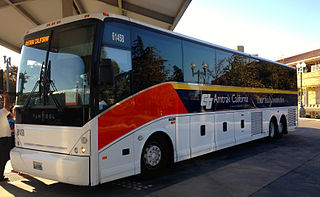
Amtrak Thruway is a system of through-ticketed transportation services to connect passengers with areas not served by Amtrak trains. In most cases these are dedicated motorcoach routes, but can also be non-dedicated intercity bus services, transit buses, vans, taxis, ferry boats and commuter rail trains.

Amtrak California is a brand name used by the California Department of Transportation (Caltrans) Division of Rail for three state-supported Amtrak regional rail routes in California – the Capitol Corridor, the Pacific Surfliner, and the San Joaquins – and their associated connecting network of Amtrak Thruway transportation services.
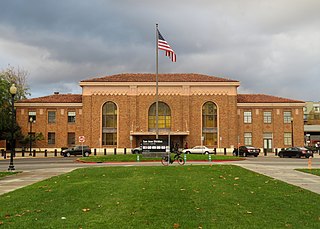
San Jose Diridon station is the central passenger rail depot for San Jose, California. It also serves as a major intermodal transit center for Santa Clara County and Silicon Valley. The station is named after former Santa Clara County Supervisor Rod Diridon Sr.

People in the San Francisco Bay Area rely on a complex multimodal transportation infrastructure consisting of roads, bridges, highways, rail, tunnels, airports, seaports, and bike and pedestrian paths. The development, maintenance, and operation of these different modes of transportation are overseen by various agencies, including the California Department of Transportation (Caltrans), the Association of Bay Area Governments, San Francisco Municipal Transportation Agency, and the Metropolitan Transportation Commission. These and other organizations collectively manage several interstate highways and state routes, eight passenger rail networks, eight trans-bay bridges, transbay ferry service, local and transbay bus service, three international airports, and an extensive network of roads, tunnels, and bike paths.

Sprinter is a hybrid rail service operating in the North County area of San Diego County between the cities of Escondido and Oceanside, California, United States. The service uses the 22-mile (35 km) Escondido Subdivision of the San Diego Northern Railroad. Station platforms were constructed for the line's fifteen stations serving the cities of Oceanside, Vista, San Marcos, and Escondido. The line provides service to California State University, San Marcos and Palomar College. Sprinter service operates every 30 minutes and is targeted towards students and commuters.

Santa Cruz Metropolitan Transit District (SCMTD), or simply Santa Cruz METRO, provides bus service throughout Santa Cruz County, California. In 2022, the system had a ridership of 3,097,100, or about 8,300 per weekday as of the third quarter of 2023.

Santa Clara Transit Center is a railway station in downtown Santa Clara, California. It is served by Caltrain, Amtrak Capitol Corridor, and Altamont Corridor Express (ACE) trains. It is the planned terminus for the Silicon Valley BART extension into Santa Clara County on the future Green and Orange Lines. The former station building, constructed in 1863 by the San Francisco and San Jose Railroad, is used by the Edward Peterman Museum of Railroad History.

Chatsworth station is an intermodal passenger transport station in the Los Angeles neighborhood of Chatsworth, United States. It is served by Amtrak inter-city rail service, Metrolink commuter rail service, Los Angeles Metro Busway bus rapid transit, and several transit bus operators.
The San Benito County Local Transportation Authority (LTA) is the public transportation agency of San Benito County, California, immediately south of Silicon Valley (Santa Clara County). LTA provides fixed route inter-county and intra-city service as San Benito County Express; the Intracounty routes connect destinations in Hollister and San Juan Bautista to Gilroy in Santa Clara County, while the Tripper routes connect destinations within Hollister. LTA also provides demand-responsive dial-a-ride service within selected areas of northern San Benito County as County Express On-Demand.

The VTA light rail system serves San Jose and nearby cities in Santa Clara County, California. It is operated by the Santa Clara Valley Transportation Authority, or VTA, and consists of 42.2 miles (67.9 km) of network comprising three main lines on standard gauge tracks. Originally opened on December 11, 1987, the light rail system has gradually expanded since then, and currently has 60 stations in operation.
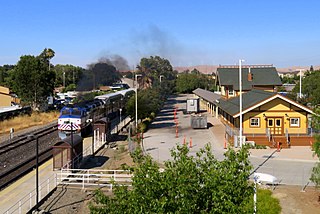
Livermore is a train station in downtown Livermore, California.

Robert J. Cabral Station, is a railway station in Stockton, California. In 2003, the station building was named in honor of the late Robert J. Cabral, a San Joaquin County supervisor instrumental in the creation of the Altamont Corridor Express (ACE), originally Altamont Commuter Express.
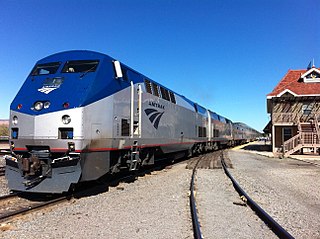
The United States is serviced by a wide array of public transportation, including various forms of bus, rail, ferry, and sometimes, airline services. Most established public transit systems are located in central, urban areas where there is enough density and public demand to require public transportation. In more auto-centric suburban localities, public transit is normally, but not always, less frequent and less common. Most public transit services in the United States are either national, regional/commuter, or local, depending on the type of service. Sometimes "public transportation" in the United States is an umbrella term used synonymously with "alternative transportation", meaning any form of mobility that excludes driving alone by automobile. This can sometimes include carpooling, vanpooling, on-demand mobility, infrastructure that is oriented toward bicycles, and paratransit service. There is public transit service in most US cities.

The Yosemite Area Regional Transportation System (YARTS) is a public transit bus line based in Merced, California. YARTS provides scheduled fixed route service between Yosemite National Park and gateway communities. Service operates year-round on Highway 140, providing access to Merced and Mariposa counties. During the peak summer months, additional service is added along Highway 120 providing access to Tuolumne County, Highway 41 providing access to Fresno and Madera counties, and eastern Highway 120/US 395 providing access to Mono County.
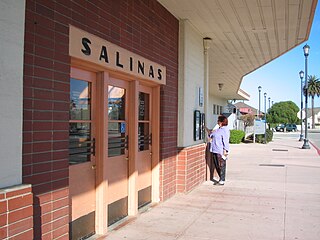
The Monterey County Rail Extension is a planned commuter rail extension that would bring Caltrain passenger service south of its existing Gilroy, California terminus to Salinas in Monterey County, using the existing Coast Line owned by Union Pacific (UPRR). Implementation of the rail extension will occur over three phases, starting from Salinas and moving north. When construction is complete, there will be four trains operated over the extended line per weekday: two northbound trains that depart from Salinas and travel to San Francisco in the morning, and two southbound trains that return to Salinas in the afternoon.



















